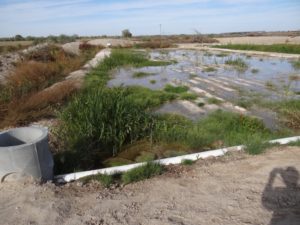by Hal N. Anderson, Manager, Clean Water Partners LLC.
Can bio-engineered sediment basins and constructed wetlands improve water quality in the Boise River by reducing levels of phosphorus and sediment? In 2014, Clean Water Partners, LLC, (CWP), began a demonstration project at the North Alkali Drain in Canyon County to find out. Now, after four years of operation, data collected by CWP provide evidence that constructed wetlands and sediment basins effectively capture sediment and phosphorus.
Data Report part 1 Data Report part 2


The Alkali Drain has agricultural runoff from crop land and concentrated animal feeding operations (CAFOs). The location of this drain at the lower end of the Boise River basin includes non-point sources along the drain as well as accumulated pollution loads from upstream sources. This pilot demonstration project is testing the concept that low tech and natural processes can effectively reduce sediment and phosphorus and provide scientific documentation of results. It is an objective to transport the techniques and processes used to other drainages. With the information generated by this project, regulators, NPDES permit holders and river managers will be better informed regarding the means and methods for nutrient removal from the Lower Boise River and similar basins in Idaho and the West.
This project was designed to be both operational in that water quality is being improved, but maybe more importantly, the project was designed to provide an opportunity for additional research. Improving water quality, especially from non-point sources, requires a diversified approach. While projects like North Alkali are not the only solution, when combined with on-farm, re-use, and water use efficiency improvements, sediment basins and constructed wetlands can provide cost effective and quantifiable improvements to water quality.


 The project was funded 60 percent by federal Clean Water Act funds distributed by Idaho DEQ and the Lower Boise Watershed Council and Canyon Soil and Water Conservation District. The 40 percent match came from the land owner, CWP, The Parma Company and others. CWP committed to measuring the project results for five years and is currently in the last year of monitoring. The results have provided very useful information on the effectiveness of constructed basins and constructed wetlands and also valuable details on how future projects should be designed and operated. Since the project began operation in 2014 approximately 130 pounds of phosphorus and 34 tons of sediment have been removed from the drain water before it enters the Snake River just upstream from the confluence of the Boise and Snake Rivers.
The project was funded 60 percent by federal Clean Water Act funds distributed by Idaho DEQ and the Lower Boise Watershed Council and Canyon Soil and Water Conservation District. The 40 percent match came from the land owner, CWP, The Parma Company and others. CWP committed to measuring the project results for five years and is currently in the last year of monitoring. The results have provided very useful information on the effectiveness of constructed basins and constructed wetlands and also valuable details on how future projects should be designed and operated. Since the project began operation in 2014 approximately 130 pounds of phosphorus and 34 tons of sediment have been removed from the drain water before it enters the Snake River just upstream from the confluence of the Boise and Snake Rivers.
Editor’s Note: The Boise River Enhancement Plan recognizes the effectiveness of constructed wetlands and sediments basins, but cautions they require constant maintenance to dredge and harvest wetland plants.